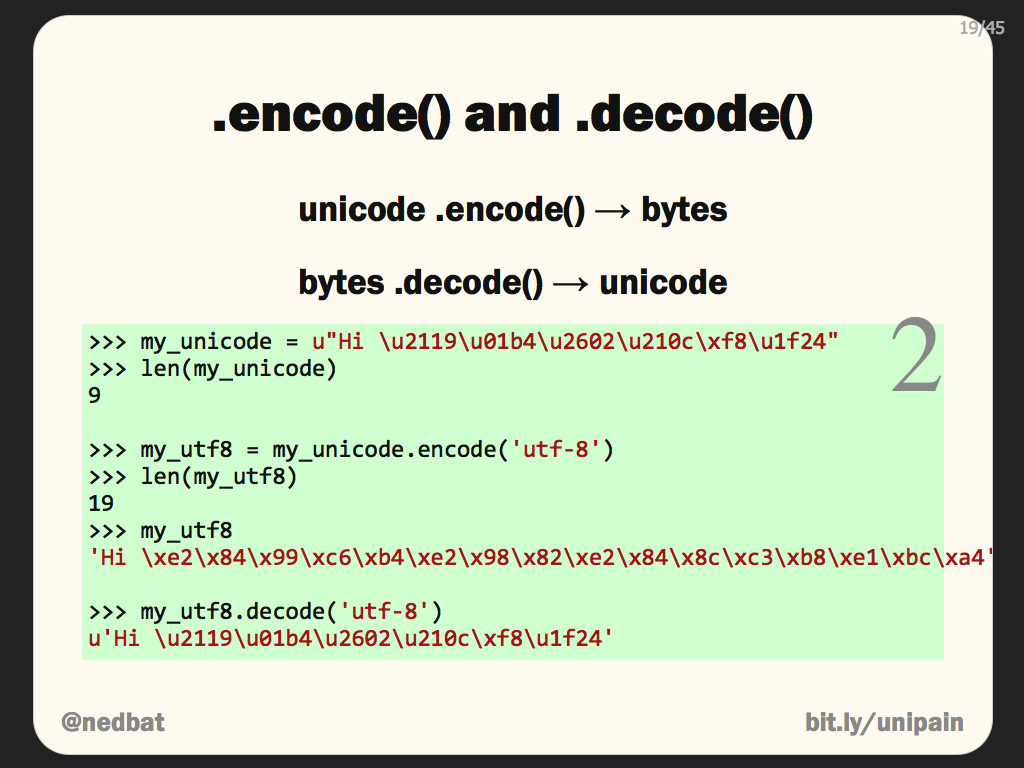
If the error is specified as 'strict', then the encoding errors raise a UnicodeError. The python string decode() method that takes 'utf_16' as its encoding has a variable length encoding done. The python string decode() method returns a decoded string. Other possible values are 'ignore', 'replace', 'xmlcharrefreplace', 'backslashreplace' and any other name registered via codecs.register_error(). The default for errors is 'strict' which means that the encoding errors raise a UnicodeError. For a list of all encoding schemes, please visit: Standard Encodings.Įrrors − This parameter specifies an error handling scheme. The following are the parameters of the python string decode() function.Įncoding − This parameter specifies the encodings to be used. Str.decode(encoding='UTF-8',errors='strict') The syntax of the python string decode() method is as follows. In the following section, we will be learning more details about the python string decode() method. Finally, this method returns the decoded string.

During this process, different error handling schemes can be set using the errors parameter. Based on the specified encoding, the string is decoded. There are various types of standard encodings such as base64, ascii, gbk, hz, iso2022_kr, utf_32, utf_16, and many more. This function works based on the parameters specified which are encoding and the error. The encoded string can be decoded and the original string can be obtained with the help of this function. If you require more secure data transmission, you should explore other encryption methods such as AES or RSA.The python string decode() method decodes the string using the codec registered for its encoding. It’s important to note that while Base64 encoding can make data transmission easier, it does not provide any security or encryption. Python’s built-in base64 module provides a simple and efficient way to encode and decode messages using Base64.īy following the steps presented in this tutorial, you can easily encode and decode messages using Base64 in Python. Using Base64 encoding, we can easily transfer binary data in a text format over email, social media, and other messaging platforms. This will give us the original message that was encoded in Base64. `decoded_message_str = decoded_message_code(‘ascii’)` We can convert the decoded message back to a string using Python’s `decode()` function. The `b64decode()` function decodes the message from Base64 format back to bytes. `decoded_message_bytes = base64.b64decode(encoded_message_bytes)`

Now that we have the encoded message in bytes, we can decode it using the `b64decode()` function from the base64 module. Here, we have converted the encoded message string “SGVsbG8gV29ybGQh” to bytes using the `encode()` function. `encoded_message_str = “SGVsbG8gV29ybGQh” encoded_message_bytes = encoded_message_str.encode(‘ascii’)` Next, we have to convert the Base64 encoded message to bytes using Python’s `bytes()` function. The first step is to import the base64 module. This will give us the encoded message in string format.ĭecoding a Message Using Base64 and Pythonĭecoding a Base64 message follows a similar process to encoding one. `encoded_message_str = encoded_code(‘ascii’)` We can convert the encoded message back to a string using Python’s `decode()` function. The `b64encode()` function encodes the message in Base64 format and returns the encoded message as bytes. `encoded_message = base64.b64encode(message_bytes)` Now that we have the message in bytes, we can encode it using the `b64encode()` function from the base64 module. The `ascii` parameter specifies that we want the string to be encoded using the ASCII character set. In this example, we have converted the string “Hello World!” to bytes using the `encode()` function. `my_message = “Hello World!” message_bytes = my_message.encode(‘ascii’)` This is done using Python’s built-in `bytes()` function. Once you’ve imported the base64 module, the next step is to convert the message you want to encode to bytes. The base64 module contains several functions that allow us to encode and decode messages using Base64. The first step in encoding a message using Base64 in Python is to import the base64 module.
#Python encode decode how to#
In this article, we will discuss how to encode and decode messages using Base64 and Python.Įncoding a Message Using Base64 and Python

Python is a versatile language and has several built-in functions that allow us to encode and decode messages using Base64. This makes it easier to transmit data over email, social media, and other messaging platforms that may not support binary data. One such method is Base64 encoding, which is used extensively in digital communication and cryptography.īase64 is a binary-to-text encoding scheme that converts binary data into printable ASCII characters. In today’s digital age, there is a growing need for secure and efficient methods of transferring data.


 0 kommentar(er)
0 kommentar(er)
